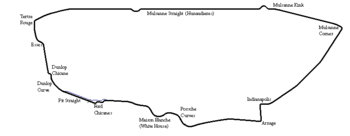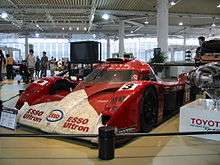1999 24 Hours of Le Mans
| 1999 24 Hours of Le Mans | |
| Previous: 1998 | Next: 2000 |
| Index: Races | Winners | |
The 1999 24 Hours of Le Mans was the 67th Grand Prix of Endurance, and took place on 12 and 13 June 1999.
Pre-race
1999 saw another increase in manufacturers involvement. Although Porsche did not send a team to contest in the prototype classes, Toyota retained their three updated GT-Ones, now moved to the LMGTP class due to the demise of GT1, while Mercedes-Benz debuted three new CLR LMGTPs. Nissan instead moved from GT1 to an open cockpit LMP, as did Panoz.
Newcomer Audi attempted to try their hand at both classes, with two open cockpit R8Rs and two closed cockpit R8Cs. BMW continued with their open cockpit LMPs, updating to the new V12 LMR.
Mercedes CLR incidents
This event became famous for the incidents involving the team of Mercedes-Benz CLRs during qualifying and the race itself. An aerodynamic design flaw in the CLR allowed for large amounts of air to build up underneath the nose of the car, especially when following another car and at the tops of hills, notably on the run to Indianapolis and on the Mulsanne Straight.
Mark Webber's CLR #4 became airborne at Indianapolis during Thursday night qualifying. On Friday, the team was allowed to rebuild #4 on a new chassis, with tweaks to the rear suspension, in an attempt by Mercedes to cure the problem. Winglets were fitted to the front to increase downforce. All cars had qualified, but during the brief warm-up on Saturday morning, Webber again became airborne[1] when following his teammates over the hump of the Mulsanne, landing on his roof and skidding to a stop in the Mulsanne corner. This car was withdrawn, but the two other CLRs continued on, again with emergency tweaks to attempt to stop the instability.
Unfortunately, a few hours into the race in lap 75, Peter Dumbreck's CLR #5 also became airborne just before the Indianapolis corner (a very bumpy section of the track), this time flying off the side of the track and landing in the trees. This incident, unlike the previous two, was caught by TV cameras and thus broadcast worldwide. Mercedes-Benz immediately withdrew the remaining CLR #6 and dropped out of sportscar racing for the immediate future.
This would be the second time Mercedes-Benz chose to drop out of Le Mans and sportscar racing following an incident with one of their cars becoming airborne and leaving the track, the first being the 1955 Le Mans disaster.
The Race
The race got off to a fast start, proceeding like a sprint for the first few hours. The top qualifying #1 & #2 Toyotas driven by Martin Brundle & Thierry Boutsen fought with the #6 Mercedes driven by Bernd Schneider, and the #5 Mercedes driven by Christophe Bouchut. The #17 BMW was never far behind and used its superior fuel economy to gain the lead through the pit stops. Toyota #1, #2, Mercedes #6 and BMW #17 all led the race at various points. At 8pm, 5 hours into the race the #17 BMW lead the race with #2 Toyota 2nd, #5 Mercedes 3rd and #6 Mercedes 4th. It was during this fight for second and third place when Dumbreck's famous incident occurred. This led to the immediate withdrawal of the remaining #6 Mercedes.
Following a lengthy safety car period as a result of Dumbreck's accident, Martin Brundle was next to go in the #1 Toyota at 11:30pm. He was trying to claw back time from an earlier mechanical issue when he suffered a puncture at high speed on braking for the first chicane on the Mulsanne Straight. The puncture sent the car veering sideways into the barrier, badly damaging the rear suspension. Martin did his best to get the car back to the pits but eventually stopped at Arnage, the car refusing to go further, possibly due to drive shaft failure caused by the flailing rubber. At the front the race was still between The #17 BMW and the #2 Toyota, they were never too far apart, the Toyota having the superior pace but the BMW able to go further on each tank. Following them were the #15 BMW and the #3 Toyota which rather than getting involved with the sprint at the front had been quietly going about their business. At around 2am the #2 Toyota being driven by Thierry Boutsen suffered a high speed crash under the Dunlop bridge, again due to a puncture. The car was destroyed and Boutsen had to be extracted from the car suffering from an injury to his lower back.
By dawn the #17 BMW was 4 laps in front of its sister 15 BMW, it looked like nothing could stop the BMW's. At approximately 10am JJ Lehto driving #17 BMW suffered a stuck throttle and crashed in the Porsche curves. The front of the car was badly damaged and could not continue. This left the sister #15 BMW almost a lap ahead of the #3 Toyota which had been quietly cruising around at a steady pace. With this sniff of a win Ukyo Katayama put the foot down in the Toyota and set the fastest lap of the race of 3:35. He narrowed the gap to less than a minute till again a tyre blowout befell the Toyota team. Ukyo was however able to return to the pits for new tyres and continued. By then bar any problems for the BMW the race was out of reach. Audi came in a respectable 3rd at their first attempt at Le Mans, setting them up nicely for the domination that was to come.
The 1999 race was the last for several of the "big" manufacturers. Only Audi returned for 2000. Mercedes pulled out of sports car racing altogether following the CLR incidents and concentrated on the new German DTM series, BMW concentrated their efforts on their supply of engines to the Williams team in F1 (who had incidentally built the BMW LMRs). Toyota also pulled out as despite their terrific pace over 98 & 99 disappointingly only one of their cars finished the race over both of those years. (Toyota would eventually return to Le Mans in 2012, as well as the 2012 FIA World Endurance Championship.)
Official results




Statistics
- Pole Position - #1 Toyota Motorsport / TTE - 3:29.930
- Fastest Lap - #3 Toyota Motorsport / TTE - 3:35.052
- Distance - 4968 km
- Average Speed - 207 km/h
- Highest Trap Speed — Toyota GT-One - 352 km/h (practice)